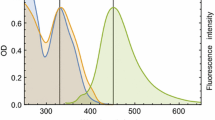Abstract
Steady-state and time-resolved fluorescence spectra of 1,3-di (1-pyrenyl)propane (1 Py-(3)-1 Py) incorporated into macromolecules of human serum albumin (HSA), into micelles of dodecyltrimethylammonium chloride (DTAC), and dissolved in 1,4-dioxane were compared. The steady-state fluorescence spectra indicated that in all the mentioned environments, upon excitation of lPy-(3)-lPy, light was emitted from the single pyrene chromophores (lPy*) and from the lPy, lPy* excimers. The time-resolved fluorescence emission registered at 480 nm (excimer emission) for lPy-(3)-lPy in the DTAC micelles and dissolved in 1,4-dioxane allowed to monitor formation of excimer with time constant τ1 = 40.0 ns and 9.6 ns, for lPy-(3)-lPy in the DTAC micelles and in 1,4-dioxane, respectively. However, when the lPy-(3)-lPy probe was located inside of the macromolecules of HSA, only the decay of emission was observed for excimer with our set-up (f > 2 ns after excitation). The instantaneous formation of excimer, unrelated to the decay of monomer excitation, indicates that the considerable fraction of lPy-(3)-lPy in the hydrophobic pockets of HSA is present as the ground state dimer. The red shift (ΔΔ = 8 nm) and broadening of UV absorption for lPy-(3)-lPy in HSA (when compared with absorption lPy-(3)-lPy in 1,4-dioxane) and comparison of excitation spectra of lPy-(3)-lPy in HSA and in 1,4-dioxane also indicate that label molecules bound to some sites of HSA are in the ground state in the dimer conformation. Moreover, the close values of the ratios of intensities of monomer emission to excimer emission, registered 2 ns (5 ns gate) after excitation pulse with duration 300 ps and at the steady-state conditions, indicate that the interconversion between conformers of lPy-(3)-lPy inside of the macromolecules of HSA is slow in comparison with the decay time of Py chromophore in the excited state in HSA (two-exponential decay with decay times τ1 = 2.41 ns, τ2 = 69.0 ns). Thus, ratios of the intensities of monomer and excimer emissions of lPy-(3)-lPy in HSA do not allow to obtain any information on the local microfluidity inside of the protein macromolecules but could be used for discrimination between different conformations of the probe, possibly located in different protein pockets.
Similar content being viewed by others
References
Lakowicz JR (1983) Principles of Fluorescence Spectroscopy. Plenum Press, New York, chapters 7 and 12
Ref. 1, p 16
Klöpfer W (1973) In: Birks JB (ed) Organic Molecular Photophysics. Wiley, London, vol 1, pp 357–402
Winnik MA (1985) In: Winnik MA (ed) Photophysical and photochemical tools in polymer science. Reidel, Dordrecht, pp 293–324
Turro N, Arora KA (1986) Polymer 27:783
Svirskaya P, Danhelka J, Redpath AEC, Winnik MA (1983) Polymer 24:319–322
Winnik MA, Redpath AEC, Paton K, Danhelka J (1984) Polymer 25:91–99
Somasundaran P, Turro NJ, Chandar P (1986) Colloids Surfaces 20:145–150
Hara K, Suzuki H (1990) J Phys Chem 94:1079–1081
Yekta Y, Duhamel J, Adiwidjaja H, Brochard P, Winnik MA (1993) Langmuir 9:881–883
Reynders P, Kühnle, Zachariasse KA (1990) J Am Chem Soc 112:3929–3939
Siemiarczuk A, Ware WR (1989) J Phys Chem 93:7609–7618
Zachariasse KA, Kühnle, Leinhos U, Reynders P, Striker G (1991) J Phys Chem 95:5476–5488
Reynders P, Kühnle W, Zachariasse KA (1990) J Phys Chem 94:4073–4082
He MX, Carter DC (1992) Nature 358: 209–215
Peters Jr T (1985) Adv Protein Chem 37:161–245
Andrade JD, Hlady V, Wei A-P, Gölan der C-G (1990) Croat Chem Acta 63:527–538
Kowalczyk D, Slomkowski S, Wang FW (1994) J Bioact Compat Polym 9: 282–309
Basinska T, Kowalczyk D, Slomkowski S, Wang FW (1994) In: Schmitz KS (ed) Macro-ion Characterization From Dilute Solutions to Complex Fluids. ACS Symp Ser 548, Am Chem Soc, Washington, pp 449–464
Winnik FM (1993) Chem Rev 93: 587–614
Clark DC, Smith LJ, Wilson D (1988) J Colloid Interface Sci 121:136–147
Dutta AK, Misra TN, Pal AJ (1996) Langmuir 12:459–465
Winnik FM, Tamai N, Yonezawa J, Nishimura Y, Yamazaki I (1992) J Phys Chem 96:1967–1972
Winnik FM, Winnik MA, Tazuke S, Ober CK (1987) Macromolecules 20: 38–44
Author information
Authors and Affiliations
Rights and permissions
About this article
Cite this article
Kowalczyk, D., Wolszczak, M. & Slomkowski, S. Fluorescence of 1,3-Di(1-pyrenyl)propane probe incorporated into human serum albumin protein enforced conformations of the probe. Colloid Polym Sci 275, 99–105 (1997). https://doi.org/10.1007/s003960050058
Received:
Accepted:
Issue Date:
DOI: https://doi.org/10.1007/s003960050058




